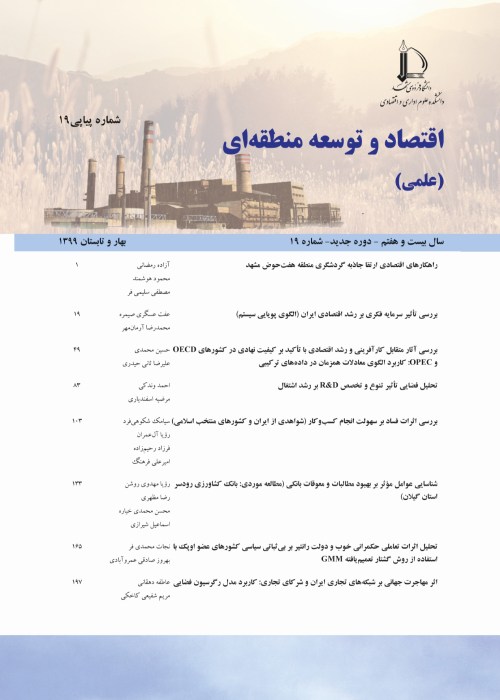The Analysis of Factors Affecting the Trade of Petrochemicals in Group D8
Author(s):
Article Type:
Research/Original Article (دارای رتبه معتبر)
Abstract:
Since the end of the Second World War, international trade has grown faster than the world production in nearly a year. In this period, trade among the developed nations has increased much faster than trade in general accounting for an increasing proportion of total trade. Balassa (1966) and Grubel (1967, 1970) demonstrated the importance of simultaneous increase by all countries regarding their exports of most industries. The pioneering studies of the gravity model were realized by Tinbergen (1962) and Pöyhönen (1963). The gravity model is analogous to Newton's law of gravity, where the state gravity between two objects is directly related to each other and inversely related to distance. Anderson's (1979) and Deardorff (1998) have considered that the gravitational equation helps explain the pattern of international trade.
In the 1980s, Romer (1986, 1990), and Lucas (1988) studied the endogenous growth models. Endogenous growth theories identify a number of channels that affects growth, such as productivity, human capital, and openness. Most of the studies show that trade and economic growth are positively correlated.
When economic geography was born in 1990s some authors as in Krugman (1993) explained the relationship between North and South considering the mobility between the countries. This process involves trade flows, migration, and direct foreign investment.
In last years, a number of gravity models have been applied to explain the bilateral trade flows (Egger 2002; Serlenga & Shin 2007; Faustino & Leitão, 2008).
The objective of this paper is to examine the pattern of Iran trade by adopting an argument gravity model. The manuscript uses a panel data approach. This study analyses the link between gravity model and Iran trade. The manuscript considers the determinants of Iran and and D8 countries within the years of 2006 to 2015. This study uses country-specific characteristics (per capita income, market size, geographical distance, and factor endowments).The structure of the paper is a follows.
This model is analogous to Newtons law of gravity, which states that the gravity between two objects is directly related to their masses and inversely related to their distance.
Where Fij denotes the flow from country i to country j. Yi and Yj are the economic sizes of the two countries, usually measured as the gross domestic product (GDP), or per-capita GDP. Dij is the distance between the countries. G is a gravitational constant.
In order to facilitate the econometric estimations, we apply logs the gravity equation (1), hence, we obtain a linear relationship as follows: Where lnG corresponds to the intercept, while , and are elasticitys.
According to the gravity approach, the trade between the two countries is directly related to their incomes (or per-capita incomes) and inversely related to the distance between them.
Since the pioneering studies of Tinbergen (1962), Pöyhönen (1963), Anderson (1979), Pagoulatos and Sorensen (1975), Caves (1981), Toh (1982), Krugman, (1997), and Badinger and Breuss (2008) the geographic distance has been an important determinant of trade. The distance can be analyzed in terms of geography, culture, language, and adjacency (Border). Rauch (1999) and Eichengree and Irwin (1998) emphasize the importance of border and common language.
Anderson (1979) introduced the product differentiation by country of origin assumption. A few years later Bergstrand (1985), Egger (2002) and Grossman and Helpman (2005) used the income per capita to specify the supply side of economies.
Usually geographic distance measures the cost of transport. According to the literature there is an increase in the flow of trade if the transportation costs decrease. The theoretical predictions show a negative correlation between distance and the trade. Balassa (1966), Balassa and Bauwens (1987), Stone and Lee (1995), Clark and Stanley (2003), and Badinger and Breuss (2008) found a negative sign between geographical distance and trade.
The empirical model uses the dummy variables to the cultural distance, language, and to the border.
The similarities of the countries encourage bilateral trade. Frankel et al. (1998) and Papazolou et al. (2006) demonstrate the importance of these qualitative variables to analyze the regional trading agreements (RTAs).
Balassa (1966) and Balassa and Bauwens (1987) found a positive sign. The empirical studies show that gravity models utilize gravitational factors as in volume of trade, capital follows, and migration (Baltagi et al., 2003; Faustino & Leitão, 2008; Kabir & Salin, 2010; Leitão & Faustino, 2009, 2010; Serlenga & Shin, 2007; Skabic & Orlic, 2007; White, 2009).
Where is bilateral trade (exports plus imports), is a set of explanatory variables.
All variables are in the logarithm form; is the unobserved time-invariant specific effects; captures a common deterministic trend; e is a random disturbance assumed to be normal, and identical distributed (IID) with .
The combined data used within the period of 2006 to 2015 for each of the commodity groups HS28 (inorganic chemical products), HS29 (organic chemical products), and HS38 (various products of the chemical industry) with a large database and in a minimum method ordinary squares, fixed effects, and random effects are estimated. The results of the study showed that the explanatory power of the model was high for all the three groups of products and the volume of trade of the HS28 commodity group with regard to the GDP of the exporters and the GDP of the importers,.Meanwhile, the size, economic dimensions, and the per capita income have significant direct effects. Trade imbalance and distance have a significant but inverse effect on the business flow of the countries under study.
In the 1980s, Romer (1986, 1990), and Lucas (1988) studied the endogenous growth models. Endogenous growth theories identify a number of channels that affects growth, such as productivity, human capital, and openness. Most of the studies show that trade and economic growth are positively correlated.
When economic geography was born in 1990s some authors as in Krugman (1993) explained the relationship between North and South considering the mobility between the countries. This process involves trade flows, migration, and direct foreign investment.
In last years, a number of gravity models have been applied to explain the bilateral trade flows (Egger 2002; Serlenga & Shin 2007; Faustino & Leitão, 2008).
The objective of this paper is to examine the pattern of Iran trade by adopting an argument gravity model. The manuscript uses a panel data approach. This study analyses the link between gravity model and Iran trade. The manuscript considers the determinants of Iran and and D8 countries within the years of 2006 to 2015. This study uses country-specific characteristics (per capita income, market size, geographical distance, and factor endowments).The structure of the paper is a follows.
This model is analogous to Newtons law of gravity, which states that the gravity between two objects is directly related to their masses and inversely related to their distance.
Where Fij denotes the flow from country i to country j. Yi and Yj are the economic sizes of the two countries, usually measured as the gross domestic product (GDP), or per-capita GDP. Dij is the distance between the countries. G is a gravitational constant.
In order to facilitate the econometric estimations, we apply logs the gravity equation (1), hence, we obtain a linear relationship as follows: Where lnG corresponds to the intercept, while , and are elasticitys.
According to the gravity approach, the trade between the two countries is directly related to their incomes (or per-capita incomes) and inversely related to the distance between them.
Since the pioneering studies of Tinbergen (1962), Pöyhönen (1963), Anderson (1979), Pagoulatos and Sorensen (1975), Caves (1981), Toh (1982), Krugman, (1997), and Badinger and Breuss (2008) the geographic distance has been an important determinant of trade. The distance can be analyzed in terms of geography, culture, language, and adjacency (Border). Rauch (1999) and Eichengree and Irwin (1998) emphasize the importance of border and common language.
Anderson (1979) introduced the product differentiation by country of origin assumption. A few years later Bergstrand (1985), Egger (2002) and Grossman and Helpman (2005) used the income per capita to specify the supply side of economies.
Usually geographic distance measures the cost of transport. According to the literature there is an increase in the flow of trade if the transportation costs decrease. The theoretical predictions show a negative correlation between distance and the trade. Balassa (1966), Balassa and Bauwens (1987), Stone and Lee (1995), Clark and Stanley (2003), and Badinger and Breuss (2008) found a negative sign between geographical distance and trade.
The empirical model uses the dummy variables to the cultural distance, language, and to the border.
The similarities of the countries encourage bilateral trade. Frankel et al. (1998) and Papazolou et al. (2006) demonstrate the importance of these qualitative variables to analyze the regional trading agreements (RTAs).
Balassa (1966) and Balassa and Bauwens (1987) found a positive sign. The empirical studies show that gravity models utilize gravitational factors as in volume of trade, capital follows, and migration (Baltagi et al., 2003; Faustino & Leitão, 2008; Kabir & Salin, 2010; Leitão & Faustino, 2009, 2010; Serlenga & Shin, 2007; Skabic & Orlic, 2007; White, 2009).
Where is bilateral trade (exports plus imports), is a set of explanatory variables.
All variables are in the logarithm form; is the unobserved time-invariant specific effects; captures a common deterministic trend; e is a random disturbance assumed to be normal, and identical distributed (IID) with .
The combined data used within the period of 2006 to 2015 for each of the commodity groups HS28 (inorganic chemical products), HS29 (organic chemical products), and HS38 (various products of the chemical industry) with a large database and in a minimum method ordinary squares, fixed effects, and random effects are estimated. The results of the study showed that the explanatory power of the model was high for all the three groups of products and the volume of trade of the HS28 commodity group with regard to the GDP of the exporters and the GDP of the importers,.Meanwhile, the size, economic dimensions, and the per capita income have significant direct effects. Trade imbalance and distance have a significant but inverse effect on the business flow of the countries under study.
Keywords:
Language:
Persian
Published:
Journal of Economy and Regional Development, Volume:24 Issue: 14, 2018
Pages:
29 to 45
magiran.com/p1837522
دانلود و مطالعه متن این مقاله با یکی از روشهای زیر امکان پذیر است:
اشتراک شخصی
با عضویت و پرداخت آنلاین حق اشتراک یکساله به مبلغ 1,390,000ريال میتوانید 70 عنوان مطلب دانلود کنید!
اشتراک سازمانی
به کتابخانه دانشگاه یا محل کار خود پیشنهاد کنید تا اشتراک سازمانی این پایگاه را برای دسترسی نامحدود همه کاربران به متن مطالب تهیه نمایند!
توجه!
- حق عضویت دریافتی صرف حمایت از نشریات عضو و نگهداری، تکمیل و توسعه مگیران میشود.
- پرداخت حق اشتراک و دانلود مقالات اجازه بازنشر آن در سایر رسانههای چاپی و دیجیتال را به کاربر نمیدهد.
دسترسی سراسری کاربران دانشگاه پیام نور!
اعضای هیئت علمی و دانشجویان دانشگاه پیام نور در سراسر کشور، در صورت ثبت نام با ایمیل دانشگاهی، تا پایان فروردین ماه 1403 به مقالات سایت دسترسی خواهند داشت!
In order to view content subscription is required
Personal subscription
Subscribe magiran.com for 70 € euros via PayPal and download 70 articles during a year.
Organization subscription
Please contact us to subscribe your university or library for unlimited access!



